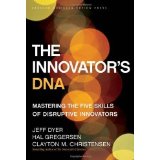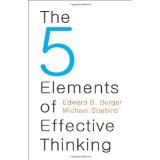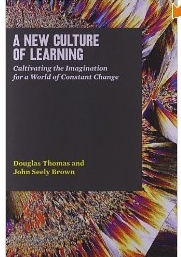So, I finally got this done and I’ll continue with the top three readings that I just found extremely useful in my teaching last year.
3. The Innovators’ DNA: by J. Dyer, H. Gregersen and C. Christensen
I rarely recommend books that I have not read yet, but this one is actually on my list to read next so I am recommending it because everything about it just feels right to me. Again, this is not an education book, but a book that is really for business people. The research that was done in preparation for writing this book was looking to see what characteristics people who are viewed as transformative innovators in the business world all share. The authors have come up with five major traits or behaviors that innovators share –
- associating
- questioning
- observing
- experimenting
- networking
You can read a wonderful summary of this book at this link, but I would highly recommend the book as well. It is our job as progressive educators and teachers of PBL to teach these skills. If it isn’t obvious to us already, as PBL teachers, I’ll say it again – that PBL is custom-made for teaching these types of skills which clearly is what this book is stating employers are now looking for.
One thing that I do not read enough of is how PBL encourages the skill of associating. I write a lot about this in my blog and researched it in my dissertation. In fact, connection is one of the main themes that came out in my research that students enjoyed about PBL. The skill of associating is a major skill that is extremely important to innovation and in fact, Steve Jobs in quoted as saying, “Creativity is connecting things.” Allowing students to practice making those connections themselves is key in order for students to practice their own creativity, especially in mathematics.
2. The Five Elements of Effective Thinking by Ed Burger and Michael Starbird
This little gem, published in 2012, was the focus of Ed Burger’s key note address at the 2012 NCTM Annual conference. He actually didn’t try to sell the book too much, but focused on the idea of teaching effective thinking (so then, yeah, I went and bought the book – what can I say, he’s a great speaker). As I was reading through it, all I could think about was how relevant it was to teaching mathematics with PBL. If every student in a PBL classroom took to heart every one of the five elements that are put forth in this book, the classroom would be so much more effective (as would any classroom).
So Burger and Starbird but forth these five elements of effective thinking:
- Understand Deeply
- Make Mistakes
- Raise Questions
- Follow the Flow of Ideas
- Change (which they call the Quintessential Element)
So, you might ask – what’s so great about those? I know this? Well, it’s not those five that are so great – if you are a PBL teacher you probably are already telling your students these already. What I think is so great about this book are the pieces of advice that Burger and Starbird give for each of these five elements. In each chapter, these are not only examples from their own teaching but actual ways to promote each of these elements not only individually but in your classroom as well. The anecdotes that are shared in the book are not only heart-warming but as a teacher you can see how you can make them useful in your own practice.
The combination of deliberately stating these five (and adding CHANGE as the most important) is really key for PBL. Students may know that you want them to understand deeply and in order for them to do that they need to raise questions about their own understanding, but if you don’t constantly and deliberately create a culture for them and you in your classroom it is not a message they will receive seriously.
And the best book, that I would highly recommend reading:
This book, in my opinion, is what PBL is all about. Whether you teach in a school that uses a problem-based curriculum, uses text books and is trying projects, or if you are just trying to create a more student-centered approach to your teaching – this book is getting at the heart of what is creating a change in our schools nationwide. It is why there is a huge movement going on with teachers in our nation trying to find something different to do in their classrooms. Thomas and Brown describe this movement as a shift from a “teaching-centered culture” in our nation’s schools to a “learning-centered culture” which may be the most important shift in education since organized schooling began in the U.S. altogether.
This shift is based on the idea that knowledge is flexible (yes, the idea of Truth with the capital T does not exist – shhhh, don’t tell anyone). Even in mathematics, the way that we solve problems and even the mathematics that we teach students – which topics are “most important” today- is changing rather regularly. This has become so much more clear and visible because of not only the Internet itself, but our access to it. Thomas and Brown suggest that we must be willing to admit that what is most important about education now is not what we teach in schools, but how students learn. Can a student learn in the collective? Are they able to harness different modes of inquiry? Do they experiment in their learning? This shift in the purpose of schooling is not really new to teachers but to our society it is major. Teachers need to learn how to make this switch and articulate the deliberateness of what they are doing in their classroom in order to focus on the shift. (By the way, this also has major ramifications for teacher educators).
I love the five dispositions that will help construct the new culture of learning (very applicable to a PBL environment!)
- Keep an eye on the bottom line (ultimate goal is to improve)
- Understand the power of diversity (strongest teams are rich mix of talents and abilities)
- Thrive on change (create, manage, seek out change)
- See learning as fun (reward is converting new knowledge into action)
- Live on the edge (explore radical alternatives and innovative strategies, discover insights)
All of this is so relatable to my own classroom and curriculum. The more I create problems and experiences that allow my students do have these dispositions, the more I know that I am fostering the “culture of learning” instead of a traditional culture of “teaching.”
So that’s it. My top 5 list of readings for PBL teachers – please let me know what you think and if you end up utilizing any of these authors’ ideas. I know that I have been invigorated by these readings and hope that you will be as well! Have a happy and fulfilling 2014!
